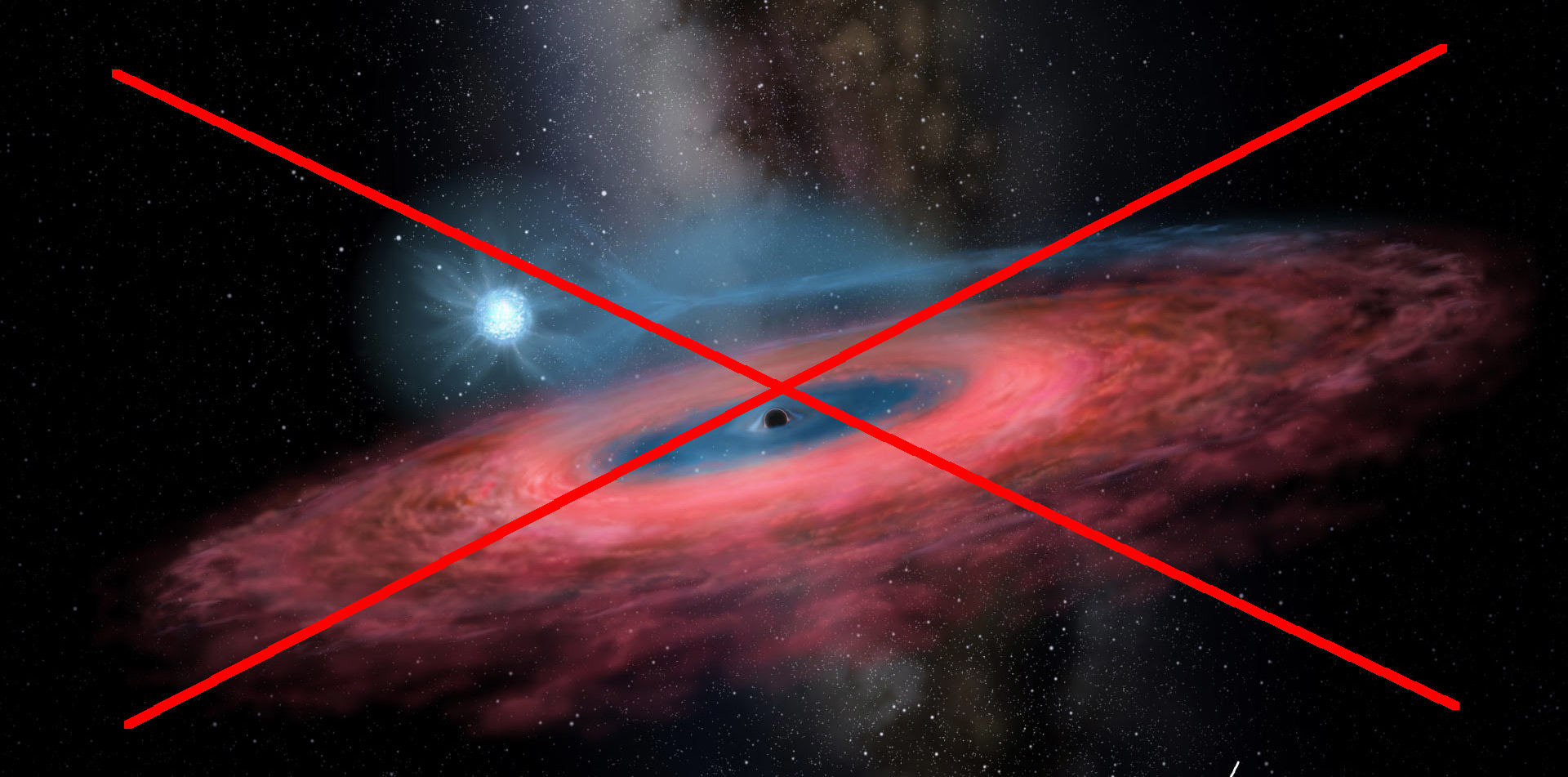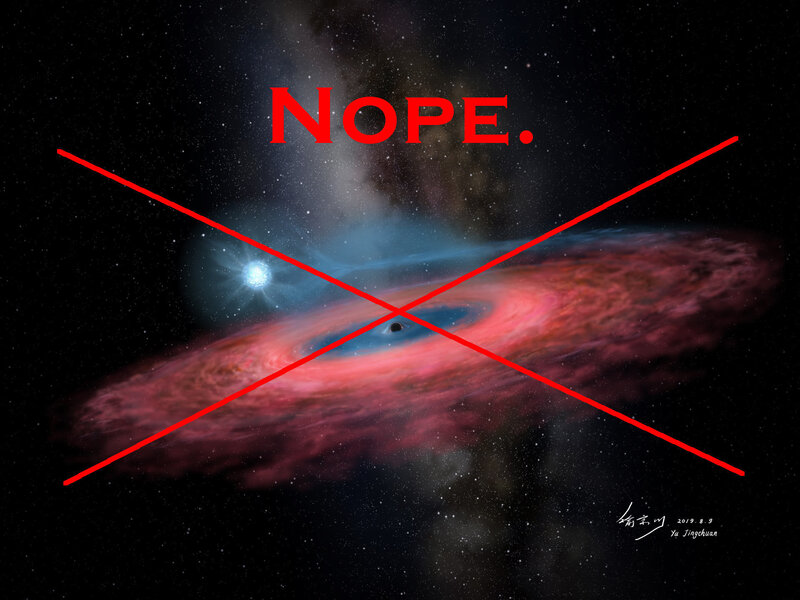Create a free profile to get unlimited access to exclusive videos, sweepstakes, and more!
So, about that 'too massive' black hole… yeah, not so much.

Last week, I wrote about what looked like a pretty important astronomical discovery: A black hole with a mass of 70 times that of the Sun.
This story was a big deal because we don’t know of any easy way to get a black hole with a mass like that. This is what’s called a stellar mass black hole, one with up to a few dozen times the mass of the Sun most likely formed when a massive star goes supernova. While the outer layers of the star explode outward, the core of the star collapses, becoming a black hole.
According to pretty much everything we know, the upper limit to a black hole like that is very roughly 30 times the Sun’s mass. That makes this one way over the limit.
The authors of the paper proposed a couple of ideas to explain this, which I’ll get to in a second. But there’s another possibility: They were, simply if bluntly put, wrong.
That looks like it’s the case. Three (3!) papers were just posted to the preprint archive challenging the 70-solar-mass claim. Two show that the scientists didn’t analyze their data properly, and a third uses theoretical models of black holes to show that the black hole has a much lower mass than claimed, and supporting this the system is in fact closer to Earth than claimed as well, which in turn makes the black hole much lower mass.
As a quick review (for more detail, read my original article): LB-1 is a blue star which the original authors claimed was about 8 times the mass of the Sun, and is at a distance of about 14,000 light years. It shows a Doppler shift in its light which indicates it’s orbiting a dark object every 79 days. They also found light from warm hydrogen gas that appears to also shift every 79 days, moving in the opposite direction as the star, and so they claim the gas is orbiting the black hole. They then use this data to show that the blue star is orbiting a black hole with the unprecedented mass of 70 Suns.
Two of the new papers (Abdul-Masih et al. and El-Badry and Quataert) posted arguing against this claim make the same point: The warm hydrogen gas they see is not moving around the black hole at all! Instead, it’s likely orbiting the system as a whole, relatively far out, and the Doppler shift seen in the light from the gas is actually due to the scientists not correcting for light from the star itself.
The argument made here is subtle. Warm hydrogen gas gives off light at a specific wavelength (about 0.656 microns, in the red part of the visible light spectrum). They definitely see that light coming from this system. But! The hydrogen gas in the blue star’s atmosphere is very good at absorbing that wavelength of light. That affects the spectrum too. If you don’t compensate for that very precisely, it’ll look like the gas is moving back and forth in the opposite sense as the star. What both new papers show is that the original papers’ authors did not compensate for this correctly. They saw a shift in the gas that isn’t actually there.
It was the gas that was used as the primary way to get the mass of the black hole! Since that gas isn’t actually moving the way they thought, the mass of the black hole isn’t right either. The new papers continue on to show that the mass is more likely in the range of 5 – 20 solar masses, and probably toward the lower end of that range, much more normal for a black hole like this.
The third paper (Eldridge et al.) goes further. They use theoretical models of how binary system like this form, and show that it’s far more likely that the black hole has a mass of 4 – 7 solar masses. To show this, they also assume the distance of 14,000 light years is wrong, and in fact the system is more like 7,000 light years away. Because it’s closer, the blue star has a lower mass than the original paper claimed, as does the black hole.
How can the distance be that far off? Here’s the fun bit: The original paper used the colors of the star to get a distance of 14,000 light years. However, the Gaia mission, designed to look at the positions and distances of over a billion stars, gives the much closer 7,000 light year number. In the original paper, the authors use the bigger distance, and make some arguments that the number from Gaia isn’t correct.
In this third paper, the authors argue that this was a mistake, and the Gaia numbers are in fact accurate.
All three papers show that the original paper’s authors made a series of mistaken assumptions (the gas was orbiting the black hole, the distance from Gaia was incorrect, and that black hole binary formation models need the black hole mass to be very large). In my opinion, these arguments are pretty convincing. It seems very unlikely indeed that this black hole is too massive. Instead, the system is closer, the star has a lower mass (roughly 4 times the Sun’s mass), the gas is orbiting the system as a whole and not just the black hole, and the black hole — which does exist, no one is arguing against that — is in the much more normal mass range for one of its type.
I have to admit, when I read the paper and wrote my own article about it, some alarm bells were ringing. Not because of the arguments made by these papers, though! My problem with the system is that the authors found the stars and black hole’s mutual orbit around each other was very circular. Given their claims about the star, that seemed really unlikely to me!
Why? For one thing, when a star explodes, the explosion is generally not perfectly symmetric. It has some offset, which can give a kick to the star, accelerating it. If it’s in a binary system, that will wind up making the orbit elongated: elliptical, not circular. Also, when the star explodes it blows off most of its mass. The shape of the orbits of the two stars around each other depends on the total mass of the system; when one star suddenly sheds (say) half its mass, the orbit gets a kick to it that makes it more elliptical. It’s possible that the orbit will recircularize due to the interactions of the star and the black hole, but that takes a lot of time.
This is a problem, because the authors also claim the blue star is very young, due to its high mass and by analyzing the star’s spectrum — in that case, there simply hasn’t been enough time for the orbit to circularize. However, in the third new paper, the authors show that a circular orbit is expected if the system is closer. That means the blue star’s mass is lower, and it can be much older than claimed. There are also more arguments there about how the blue star evolved and interacted with the black hole’s progenitor star, which naturally lead to the orbit being circular even after the progenitor star exploded.
I’ll note that the day my original article on this went up, a reader pointed out to me a research paper was posted making similar arguments to this. I should’ve listened to my instincts and noted my concerns, but — and I’ll be honest here — at that point the article was so long that I feared no one would read that far! So I left them out. One of the hardest tasks of any science communicator is deciding what info not to include in an article, usually because it’s too technical, or doesn’t change the overall conclusion.
Usually, that’s not that big a deal. In this case, though, it did, and I should’ve included them, or at least noted them. Mea culpa.
Another mistake on my part was that I took a minor idea from the original paper — that perhaps the black hole looks so massive because it’s actually two smaller black holes — and emphasized it (I even made it the title of my article). I liked the idea, even if it had similar problems with circular orbits as my concerns for the overall conclusion. Again, that’s usually not a problem, but in this case it compounded the error. FWIW I added a link to that fourth paper as soon as it was pointed out to me, and added a correction to my article.
So, bottom line, it looks like this black hole exists, but it’s a more run-of-the-mill stellar mass black hole, and not one with a mass that pushes our theories past their limits. Although I’m a little embarrassed about my own errors in judgment, I’m glad the follow-up papers were published, and so quickly. Hopefully the authors of the original paper will go back, reassess their work, and issue a correction (or rebut the arguments, though again I think the arguments are correct) as well. That is, after all, how science works.















